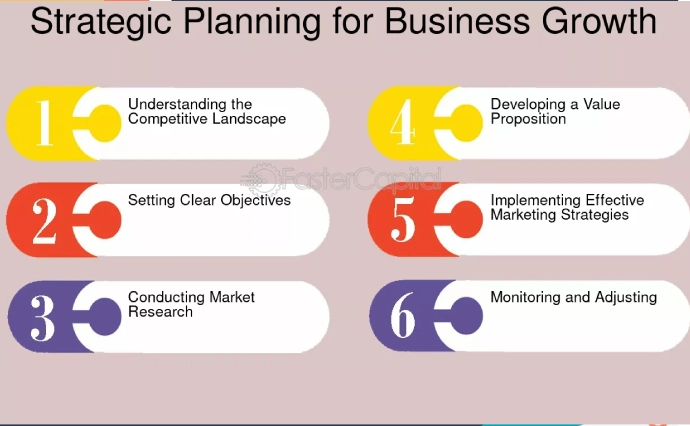Strategic business planning is the backbone of any successful organization, guiding it through the complexities of the modern business environment. At its core, strategic planning is about setting a direction for the organization, making decisions on allocating resources, and determining the steps necessary to achieve long-term goals. In today’s fast-paced world, where markets evolve rapidly and competition is fierce, having a robust strategic plan is crucial.
It helps businesses not only survive but thrive by adapting to changes, seizing opportunities, and mitigating risks. Over the years, strategic planning practices have evolved from rigid, linear processes to more dynamic and flexible approaches, accommodating the ever-changing business landscape. This comprehensive guide will explore the nuances of strategic business planning, providing a detailed roadmap for mastering this critical aspect of business management.
Understanding Strategic Business Planning
strategic-business-planning effort are the organization’s vision, mission, and values. The vision defines the desired future state, while the mission outlines the organization’s purpose, and the values represent the principles that guide decision-making. Moreover, these elements serve as the foundation for the strategic plan, ensuring that all activities align with the organization’s core beliefs and objectives. Ultimately, a well-crafted strategic business plan clarifies the organization’s direction and fosters a cohesive culture driven by success.
Types of Strategic Plans
Strategic plans can be categorized into several types, each serving a specific purpose within the organization. Long-term strategic plans typically cover a period of three to five years and focus on broad objectives that shape the future direction of the organization. Short-term strategic plans are more immediate, often covering a one-year period, and are focused on achieving specific, measurable goals within that timeframe.
Contingency planning is another crucial aspect of strategic planning, where organizations prepare for unexpected events or crises that could disrupt operations. Scenario planning involves creating multiple plausible future scenarios and developing strategies to address each potential outcome. This approach allows businesses to remain agile and responsive to changes in the external environment.

The Strategic Planning Process
The strategic planning process is a systematic approach that involves several key steps:
Initial Research and Analysis: This stage involves gathering information about the internal and external environment. Tools like SWOT analysis (Strengths, Weaknesses, Opportunities, Threats) are commonly used to assess the organization’s current position and identify areas for improvement.
Setting Objectives and Goals: Based on the analysis, clear and achievable objectives are set. These goals should be specific, measurable, attainable, relevant, and time-bound (SMART).
SWOT Analysis: This involves a deeper analysis of the organization’s strengths and weaknesses, as well as the opportunities and threats in the external environment. This step helps in identifying key areas where the organization can leverage its strengths or address its weaknesses.
Developing Strategies and Action Plans: Once the objectives are set, strategies are developed to achieve them. This includes creating detailed action plans that outline the steps necessary to implement the strategies.
The team puts the strategic plan into action by allocating resources and assigning responsibilities. Effective communication and leadership play crucial roles at this stage to ensure that all team members align with the strategic goals.
Monitoring and Evaluation: Continuous monitoring and evaluation are essential to track progress and make necessary adjustments. This involves setting up key performance indicators (KPIs) and regularly reviewing them to ensure that the organization stays on track.
Tools and Techniques in Strategic Planning
Several tools and techniques can enhance the effectiveness of strategic planning:
PEST Analysis: This tool examines the Political, Economic, Social, and Technological factors that could impact the organization. It provides a macro-level understanding of the external environment.
Balanced Scorecard: This framework helps organizations translate their strategic objectives into measurable performance indicators. It balances financial and non-financial measures to provide a comprehensive view of organizational performance.
Porter’s Five Forces: This model analyzes the competitive forces within an industry, helping businesses understand the level of competition and identify potential threats.
VRIO Framework: This tool evaluates the organization’s resources and capabilities based on their Value, Rarity, Imitability, and Organization. It helps in identifying sustainable competitive advantages.
Benchmarking: This technique involves comparing the organization’s performance with industry best practices. It helps in identifying areas where improvements can be made to achieve better results.
Role of Leadership in Strategic Planning
Leadership plays a critical role in the success of strategic planning. Different leadership styles can influence how strategies are developed and implemented. Visionary leadership is particularly important in strategic planning, as it involves setting a clear and compelling vision that inspires and motivates the organization to achieve its goals.
Empowering teams is another key aspect of effective strategic planning. When leaders delegate responsibilities and encourage collaboration, it fosters a sense of ownership and accountability among team members, leading to better execution of the strategic plan.
Challenges in Strategic Business Planning
However, strategic business planning is not without its challenges. Common pitfalls include lack of alignment between the strategic plan and the organization’s vision, insufficient resources, and resistance to change. To address this, organizations must ensure that the strategic plan is realistic, achievable, and well-communicated across all levels of the organization.
Additionally, balancing short-term and long-term goals is another challenge. While short-term objectives are important for immediate success, they should not overshadow the long-term vision of the organization. Therefore, a well-balanced strategic plan considers both aspects, ensuring that short-term actions contribute to long-term success.
Strategic Planning in Different Business Environments
Strategic planning varies depending on the business environment. Startups often face unique challenges, such as limited resources and a need for rapid growth. Strategic planning for startups should focus on agility, innovation, and market entry strategies.
For established companies, strategic planning involves sustaining growth, maintaining market leadership, and exploring new opportunities. These organizations often have more resources at their disposal but must also navigate complex organizational structures and potential inertia.
Global strategic planning adds another layer of complexity, as it involves navigating different cultural, economic, and regulatory environments. Global strategies must be adaptable and sensitive to local nuances while maintaining overall alignment with the organization’s vision.
Strategic Planning and Innovation
Moreover, innovation is a key driver of long-term success in strategic planning. Integrating innovation into the strategic plan involves creating a culture that encourages creativity, experimentation, and continuous improvement. Additionally, technology plays a significant role in shaping strategy, offering new tools and platforms that enable businesses to innovate and stay competitive.
For instance, case studies of successful innovation strategies can provide valuable insights. For example, Apple’s long-term vision and commitment to innovation have made it a leader in the tech industry. Similarly, Toyota’s focus on continuous improvement and lean manufacturing has set the standard for operational excellence. Likewise, Amazon’s customer-centric approach has revolutionized the retail industry and established it as a global e-commerce giant.
Case Studies of Successful Strategic Planning
Apple Inc.: Apple’s success is rooted in its long-term vision of innovation and excellence. By focusing on creating products that are both functional and aesthetically pleasing, Apple has built a loyal customer base and established itself as a leader in the tech industry.
Toyota: Toyota’s strategic planning is characterized by its commitment to quality and continuous improvement. The company’s adoption of lean manufacturing principles has allowed it to optimize operations and deliver value to customers.
Amazon: Amazon’s strategic planning revolves around its customer-centric approach. By prioritizing customer satisfaction and leveraging technology, Amazon has disrupted traditional retail and become a dominant player in the global market.
Expert Insights on Strategic Business Planning
Experts emphasize the importance of aligning the strategic plan with the organization’s vision and values. Business leaders suggest that a successful strategic plan should be flexible, allowing for adjustments as circumstances change. They also highlight the role of leadership in driving the strategic planning process and ensuring that the entire organization is committed to achieving the goals outlined in the plan.
The Future of Strategic Business Planning
Furthermore, emerging trends such as the rise of artificial intelligence (AI) and big data will likely shape the future of strategic business planning. These technologies offer new ways to analyze information, predict trends, and make informed decisions. As a result, as businesses become more data-driven, strategic planning will need to evolve to incorporate these tools and stay ahead of the competition.
In addition, looking ahead, the next decade in strategic planning will likely see a greater emphasis on sustainability, social responsibility, and ethical considerations. Organizations will need to balance profitability with the need to contribute positively to society and the environment.
Frequently Asked Questions
What is strategic business planning, and why is it important?
Strategic business planning is the process of defining a company’s direction and making decisions on allocating resources to achieve long-term goals. Organizations set clear objectives, stay competitive, and adapt to changes in the business environment, making it important.
Q:How does strategic planning differ from tactical planning?
Strategic planning focuses on long-term goals and the overall direction of the organization, while tactical planning deals with short-term actions and day-to-day operations that support the strategic objectives.
Q:What are the key steps involved in the strategic planning process?
The strategic planning process typically involves initial research and analysis, setting objectives and goals, conducting a SWOT analysis, developing strategies and action plans, implementing the plan, and monitoring and evaluating progress.
Q : What tools and techniques do organizations commonly use in strategic business planning?
Common tools and techniques include SWOT analysis, PEST analysis, the Balanced Scorecard, Porter’s Five Forces, and the VRIO Framework. These tools help organizations assess their internal and external environments and develop effective strategies.
Q:How can businesses ensure their strategic plans are successful?
To achieve this, to ensure the success of a strategic plan, businesses should align the plan with their vision and values, involve leadership and key stakeholders in the planning process, monitor progress regularly, and be flexible enough to make adjustments as needed..
Q: What is strategic business planning?
Moreover, strategic business planning is the process of defining a company’s direction and making decisions on allocating its resources to pursue this strategy. It involves setting goals, analyzing the competitive environment, and formulating strategies to achieve long-term success.
Q: Why is strategic planning important for businesses?
Strategic planning is crucial because it provides a sense of direction and outlines measurable goals. It’s a tool for guiding day, to, day decisions and evaluating progress while moving towards larger objectives.
Conclusion
Strategic business planning is essential for any successful organization. It creates a roadmap for achieving long-term goals, adapting to changes, and staying competitive in an ever-evolving market. By understanding the key concepts, tools, and techniques of strategic planning, businesses position themselves for success.
The ongoing importance of strategic planning cannot be overstated. Moreover, as the business environment continues to change, organizations must be proactive in their planning efforts, constantly seeking new opportunities and ways to innovate. By doing so, businesses can adapt to emerging trends and challenges effectively. Furthermore, by mastering the art of strategic business planning, businesses can ensure their long-term success and make a meaningful impact in their industry.




Comments are closed.